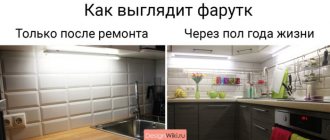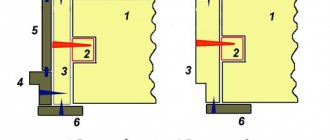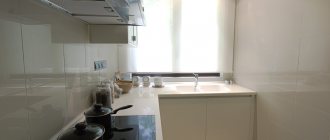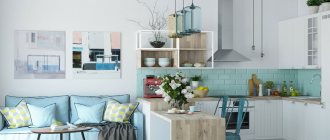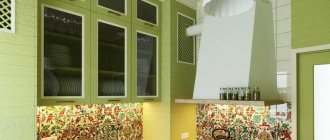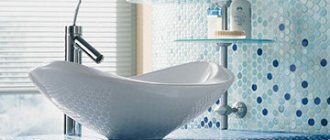The question of what material is best to choose for the kitchen arises for most buyers long before purchasing furniture. Each type of material has its own advantages and disadvantages, different prices and properties. Choosing it is a responsible step, since the appearance and service life of your kitchen directly depends on it.
Modern technologies produce high quality kitchen furniture from chipboard, MDF and wood. And with proper processing, even inexpensive materials can last a long time.
Modern technologies make it possible to make high-quality kitchen furniture from chipboard, MDF and wood. With proper processing, even the most inexpensive materials will look noble and last a long time.
It is necessary to consider in detail what material to choose a kitchen from, taking into account all the features and pitfalls.
The advantages of such a layout
Using a cozy and compact kitchen without wall cabinets has a number of practical advantages:
- Cozy indoor environment.
- Enough space is freed up for decoration and arrangement of the area. A small kitchen without cabinets takes on a completely different look.
- Compact arrangement of furniture.
- Safety, especially for families with young children. Wall cabinets always require owners to provide high-quality and constant monitoring of the condition of the fasteners and underlying walls.
- A special kitchen design without cabinets with the ability to organize your own, individual style. Craftsmen can always choose an original wall-length panel, decorate the surface with an interesting painting or a set of polymer clay dishes.
- Availability of household items, kitchen utensils, products, which will now be stored in more accessible places.
Reducing the number of furniture greatly simplifies the cleaning process, which determines the popularity of such interior styles among owners and designers. Photos of interesting kitchen options without cabinets will help you decide on the choice of interior layout.
How to arrange furniture
First of all, you need to decide on the placement of kitchen furniture in the space: in one or two lines, in the form of the letter P or L, or the peninsula or island option will be taken as a basis. If there is a lack of free space, you can easily select a small corner set, but you need to accurately select the dimensions of the cabinets. Small corner kitchens allow you to save space as much as possible.
Is the kitchen area large enough to accommodate a table, stools or chairs? Space should be allocated for this, taking into account the possibility of comfortably moving chairs away.
Next, you need to decide on the number of cabinets and their location. Only after this can you begin to create individual versions of kitchen designs. In this case, again, it is very reasonable to resort to the help of a computer program. It will allow you to calculate not only the parameters of facades with micron accuracy, but also optimize the internal space. In this case, all the nuances will be taken into account - the location of holes, fittings, retractable elements. Everything should open effortlessly to provide access to the interior surfaces of base and wall cabinets, as well as cabinet lights.
Main problems in practice
Apartment owners and designers working on interior design have to face a number of problems. These are the main disadvantages of a kitchen without upper cabinets:
- The area of storage areas is significantly reduced. Dishes and household appliances have to be moved to other areas and systems.
- Not every furniture and electrical appliance can be installed in such a room. Very often, suspended structures serve as storage for a gas water heater, communication systems, electrical wires and packages.
- The vacant wall needs to be repaired and additional decoration done. For apartments “from scratch” this issue is not difficult, but for secondary housing it is a completely different matter. In such cases, it is necessary to carry out large-scale repairs using a high-quality design plan.
Each specific case should be approached with special attention, working through all possible options for planning, lighting design and furniture arrangement.
DIY kitchen set
It would seem that it would be easier to go to the store and choose what you like. BUT! What you like may cost as much as a villa in Spain, or it will categorically refuse to fit into your small kitchen. There is an option for “custom furniture”. But it is not always available due to a lack of financial resources, as well as decent craftsmen in the area. The truth lies on the surface: make a kitchen set with your own hands.
The motto “Eyes are afraid - hands are doing” fits this situation perfectly. If you were able to make at least one decent stool during craft lessons at school, you can safely get down to business. The main thing is to arm yourself with patience, remember accuracy and follow the simple algorithm that you will find in this article. You can read about economy class modular kitchens by following this link.
Creating a Sketch
First of all, you need a project with the arrangement of furniture as you want it to be. When creating a sketch, you should delimit the functional kitchen areas according to the rule of the working triangle. There are three of them: a cooking area, cutting food and washing dishes, and a storage area. You can make a sketch either yourself or using one of the free computer programs.
Most Popular:
- PRO-100 - considered one of the most understandable and easy to use;
- KitchenDraw;
- K3-Furniture;
- Basis-Constructor-Furniture Maker;
- Woody.
A graphic 3D editor, such as these programs, will save you from the long and careful drawing of future cabinets and bedside tables on paper. Failure to comply with the exact dimensions will ultimately lead to a room filled with lumpy and oblique objects.
What is the advantage of a computer program?
Using a virtual sketch, you can get a very realistic image of the future kitchen, choose the ideal color in the interior, and experiment with the arrangement of objects in the interior.
Just enter all the necessary parameters and trust the program. She will be able to take into account everything: the location of communications, door and window openings, architectural features of a particular room and offer interesting planning ideas.
Interesting lighting ideas
Today, lighting manufacturers and craftsmen can offer apartment owners a lot of options:
- Wall lamps (sconces, fluorescent lamps).
- Ceiling chandeliers (classic, suspended above the dining table, built into suspended ceilings).
- LED strips that can be installed directly on a wall freed from cabinets.
- Modular spotlights.
Ribbons with spotlights located along the wall, which focus attention on the decorative elements, will look interesting.
Fuchsia + black – the most interesting color duo
Photo from source: gloria-mebel.com
If you have an open plan, then creating a functional office on the back side of the kitchen unit will be an interesting solution. There will be everything you need here: shelves, storage space, and sockets. The solution is truly brilliant! After all, access to the kitchen-living room remains open, and the office is, as it were, behind the door. That is, there will be no feeling of disorder.
When thinking about the color of the design, also pay attention to anthracite, a diluting orange pumpkin shade and all shades of blue. Let's tell you more about them.
Organization of space under the table
In just a few steps you can turn the free space under the dining table into a high-quality system for storing dishes, food, and household appliances.
Additional accessories include boxes with lids, hanging hooks, and metal mesh. Also, having experience in handling a plane and a jigsaw, you can make a frame and drawers.
Countertops for custom kitchens
Choosing a countertop is important! Pay attention to products from the Kedr factory. High-quality and eco-friendly countertops, more than 180 decors - you will find what you need!
Photo from source: mykaleidoscope.ru
Tabletop Cedar 111/1 White
Tabletop Cedar 3230/S Light Sonoma Oak
Table top Cedar 7093/E Concrete
Construction of shelves on the wall
The freed up space above the work area can only be partially decorated. The remaining surface is used to organize storage systems.
One of the best options is to make open shelves. They can be arranged in a checkerboard, linear or random order. Shelves allow you to add enough free space for storing dishes, bulk cereals in jars, other products and small household appliances.
Placement of household appliances
One of the important stages when creating a sketch is the proper placement of large household appliances: stove and oven, refrigerator, dishwasher, washing machine, choosing the size of the sink.
A number of immutable rules must be observed. The refrigerator should not be located next to the stove, otherwise it may fail before its allotted time. Another undesirable neighborhood is the stove and sink. They should be located no closer than half a meter from each other. Splashes of water can not only negatively affect the condition of the stove, but also end up in the socket, so it is worth considering the option of retractable sockets for the countertop. And this already threatens a short circuit and failure of expensive kitchen appliances.
It is logical to place laundry and dishwashing units in close proximity to water supply pipes. How to choose a sink made of artificial stone can be found in this material.
Optimal use of the window sill
In a small kitchen, a wide window sill can be used as a storage area, on which racks for dishes, food boxes, and decorative elements are located.
Lighting fixtures (table lamps with lampshades) and a dish dryer with a tray can also be installed on the windowsill. In miniature kitchen spaces, it is important to use every available corner to plan efficiently.
Reorganization of the construction niche
Older apartment buildings have a large number of wall niches and alcoves, which can also be used for practical purposes. The walls and floor of such a niche are leveled, covered with an antiseptic, moisture-resistant compound and antifungal solution.
After decorative finishing, you can arrange a niche: shelves, rails, hooks. Plastic boxes with lids are excellent for storing dishes and bulk products.
Self-production
Tem. If you're good with a computer, all you have to do is make the drawing yourself. You will need the most basic set of tools: a pencil, a ruler and a piece of whatman paper.
Taking measurements
This stage is necessary for both independent and virtual sketching. When making it, it is necessary to adhere to a certain scale. Preference should be given to the 1:10 option.
- Measure the basic parameters of the room, taking into account non-standard sizes.
- Draw the perimeter of the kitchen. Indicate the exact dimensions of the walls and partitions, and this must be done at different points in the room: near the ceiling and on the floor. Mark possible discrepancies on the sketch. This will help to avoid problems with placement and distortions in the future. Smaller dimensions are taken as a basis; take into account the thickness of the countertop made of chipboard or other material.
- The location of utilities must be marked: gas, sewerage, electricity. Indicate the placement of outlets and ventilation holes.
- Mark door and window openings.
The optimal unit of measurement is 1 mm.
What sizes you can't do without:
- Length and width of the room.
- The distance from the floor to the ceiling is the height of the headset, from the floor to the window sill, from the floor to the ventilation hole, between the walls, from the corner to the window, between the wall and various pipes (gas, water, etc.).
Using the bar counter
Another interesting option for planning a kitchen without wall cabinets is to make maximum use of the bar counter. On the upper tiers of the rack you can place hooks and metal mesh for glassware.
But the greatest attention should be paid to the organization of the lower contour, namely, the space under the tabletop. These can be drawers, open shelves, hanging systems. Boxes with kitchen utensils and electrical appliances can be located here.
Sections (modules)
A kitchen set is a structure consisting of sections:
- top row sections;
- bottom row sections;
- separate modules.
The top row is wall cabinets. Their parameters depend on the size of the kitchen. The height of the cabinets can vary from 300-400 mm to a meter. Their depth corresponds to the size of the dish dryer and is equal to the standard 300 mm. The parameters of the lower section should be convenient for the person who is most often in the kitchen and correspond to his height. As a rule, the height of the tabletop from the floor is 850 mm. For a non-standard sized person, different ergonomic requirements apply. You can move away from standard sizes in the direction of increasing them. In this case, it is better to choose a kitchen with built-in household appliances, since it can be easily placed at a level that is comfortable for a person.
The depth of the lower section corresponds to the size of the tabletop. As a rule, it is 600 mm, respectively, the depth of the cabinets is 50 mm less. The width of the section is affected by the choice of fittings. How to choose a countertop for the kitchen can be found in this article.
Hood
The width of the upper section depends on the size of the suspended hood located above the stove or under the shelves. The minimum distance from the hood section to the electric stove is 700 mm, to the gas stove – 100 mm more.
Calculation of kitchen cabinet dimensions (depth, width, height)
When calculating the size of kitchen cabinets, the following nuances should be taken into account. The most ergonomic height for hanging shelves above the table top is no more than 100-110 mm.
For a person of more impressive height, you can add a dozen millimeters. The minimum permissible height of the bottom shelf is about 450 - 500 mm. Otherwise, access to the entire surface of the countertop will be difficult. The standard height of the lower section (floor cabinets) is 850-900 mm. This size follows standard appliance measurements, which is important to consider when you're designing online.
The width of the cabinets can range from 20 to 90 cm, depending on the chosen project. Depth – 450-550 mm.
The main reference point for the height of the cabinets is the height of the window opening.
Watch the video instructions on how to make a kitchen with your own hands:
How to take measurements correctly
One of the main parameters taken into account when designing kitchen cabinets is the minimum length size. Increasing this parameter may result in the finished product not fitting into its intended location. It is best to subtract an additional 10 mm from the resulting minimum size. This will help avoid unpleasant inconsistencies.
It is necessary to check that the right angles correspond to the required 90 degrees. When identifying large discrepancies in the project, this nuance must be taken into account. You can correct the situation, for example, by using a lining strip.
When taking measurements, it is necessary to take into account the thickness of the panels and doors on the cabinets. Uneven walls can become a hindrance when hanging cabinets. In this case, the solution would be to increase the gap between the drawers.
Cutting materials for the project
This operation can, of course, be carried out independently, observing the utmost precision. But this is quite a big risk. Even if all the necessary rules and precautions are followed, something can go wrong and the furniture will be unusable. Therefore, it is better to order cutting of slabs in a specialized furniture workshop for quite reasonable money. This will still be more accurate and will not lead to unnecessary expenses.
You will need a clear example of how to make a kitchen:
How to assemble a corner or standard cabinet
A sketch was made, a suitable material for the cabinets was selected, and the location of household appliances was determined. Now you need to assemble the kit.
First, you need to edge all the parts with a hot iron, then trim off what is unnecessary with scissors and sand it with sandpaper.
Fasteners
Places for fastening are marked on the facades and holes are made. All parts must be marked. During the assembly process, you can immediately insert all the drawers and shelves into the cabinet after connecting the horizontal and vertical surfaces. Installation of facades is carried out at the very end. In this case, the structure should lie on the floor. The doors are secured in the open position.
The installation of the lower section is adjustable in level to obtain a perfect horizontal surface. The tabletop is attached to the lower section with self-tapping screws. After this, holes are made for the sink and stove.
We hang the upper section no lower than 600 mm from the tabletop level. A mounting rail must be attached to the wall. When hanging, it is necessary to align the cabinets in all directions.
How to finish a kitchen, visual instructions:
Decorating the front of a cabinet in the kitchen
To give the finished kitchen set an attractive appearance, you can use simple techniques such as painting, varnishing, painting or replacing facades. In addition, individual elements of the headset can be finished with special film and fabric. All necessary consumables are present in large quantities on the shelves of furniture and art stores. So, your dream kitchen is quite possible and completely inexpensive.
Just a few tips and a bit of diligence in your kitchen, an interesting and exclusive set created by you. In our other articles you can get acquainted with small kitchen corners.
Brick, stone or tile masonry
All materials used are distinguished by their stylish design, extreme strength, and ease of installation on the underlying surface. In practice, not only classic ceramic tiles are used, but also mosaics, stencil masonry, and glass blocks.
A new product on the construction products market – XXL format tiles – is used for modern interior styles (Loft, minimalism). Such coatings not only add style and gloss to the kitchen, but also meet all safety requirements.
Stencil painting
Today, several dozen ready-made stencils of all possible shapes and sizes are known. These include PVC films, cardboard templates, and silicone molds.
Lighting fixtures (for example, built-in spotlights) can be located along the contour of the wall. Sets of pottery or dishes made using the papier-mâché technique are installed on the shelves. Plates with decorative paintings can be attached directly to the wall.
Today, modern photo printing and various types of painting are often used to decorate the kitchen area. The interior of a kitchen without cabinets is a shining example of style and comfort for small spaces.

